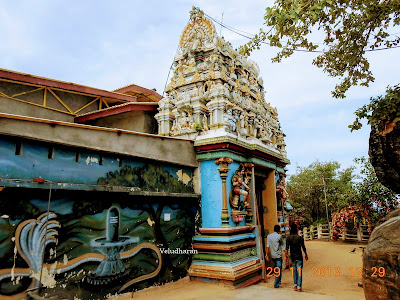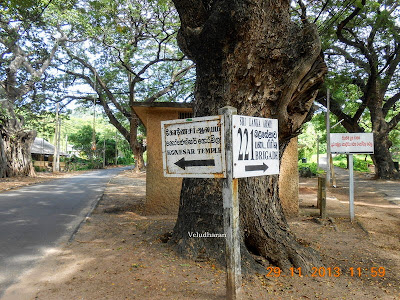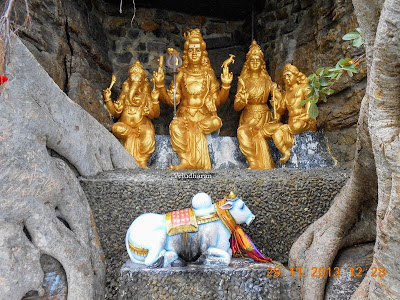This is the 273rd Thevaram Paadal Petra Shiva sthalam and the first Shiva sthalam of Eezha Nadu alias Sri Lanka. This is one of 5 Temples ends with Ishwarams dedicated to Lord Shiva in Sri Lanka. The other temples are Thiruketheeswaram, Naguleswaram (Keerimalai), Tenavaram ( Tevan Thurai ) and Munneswaram ( Puttalam ). These are very popular even before the arrival of Vijaya in 600 BCE. Literary evidences are there about the existence of this 5 temples in Sri Lanka. This place Koneswaram is praised as “Ko-Kannam – Lord’s Cheek”, Go-Karna – Cows ear, hence called as Gokarneswara, which has got corrupted to the present name of Koneswaram. This place & temple was mentioned in, Mahabharata, Ramayana, Yalpana Vaipava malai, Mattakalappu manmiyam, Kachiappa Sivachariyar’s Kandapuranam.
In Periyapuranam, Sekkizhar records that both Thirugnanasambandar and Sundrar has sung hymns in praise of Lord Shiva of Thiruketheeswaram and Trincomalee temples from Rameshwaram itself.
அந்நகரில் அமர்ந்து அங்கண் இனிது மேவி ஆழிபுடை சூழ்ந்து ஒலிக்கும் ஈழம் தன்னில்மன்னு திருக்கோணமலை மகிழ்ந்த செங்கண் மழவிடையார் தமைப்போற்றி வணங்கிப் பாடிச்சென்னிமதி புணைமாட மாதோட்டத்தில் திருக்கேதீச்சரத்து அண்ணல் செய்ய பாதம்உன்னி மிகப்பணிந்து ஏத்தி அன்பரோடும் உலவாத கிழிபெற்றார் உவகை உற்றார்
Thirugnanasambandar, Sundarar and Ramalinga Adigalar has sung in praise of Lord Shiva of this temple.
தாயினும் நல்ல தலைவர் என்றடியார் தம்மடி போற்றிசைப்பார்கள்வாயினு மனத்து மருவி நின்றகலா மாண்பினர் கண் பலவேடர்நோயிலும் பிணியுந் தொழிலர் பால் நீக்கி நுழைதரு நீலினர் ஞாலம்கோயிலுஞ் சுனைங் கடலுடன் சூழ்ந்த கோணமாமலை யமர்ந்தாரே...... திருஞானசம்பந்தர்“நாட்டும் புகழ் ஈழநாட்டில் பவ இருளை வாட்டுந் திருகோண மாமலையாய்”..... திரு அருட்பா...மன்னுதிருக் கோணமலையின் மாதுமைசேர்பென்னே கோணேசப் புராதன..... சிவநாமக் கலி வெண்பாMoolavar : Sri ThirukoneswararConsort : Sri Mathumayal
Some of the salient features of this temple are....The temple is facing east with a 3 tier Rajagopuram on east and south. Artha mandapam, Snapana mandapam, Vasantha mandapam, Yagasalai and Pagasalai are in the temple as per agamam. In Snapana mandapam Sri Sivakama Sundari Sametha Sri Natarajar.
In Deva Saba panchaloha moorthams of Sri Valli Deivanai Sametha Sri Subramaniar, Somaskandar, Chandrasekar are worth to see. In Prakaram murtis of Suriyan, Chandran, Nagar, Bhairavar, Chandikeswarar. Kasi Viswanathar. The present temple was reconstructed as per aagama. The old idols of Sri Mathumayal sametha Sri Koneswara, Chandrasekar, Parvathy, Pillayar, Asthira Devar taken from the wells and ponds were reinstalled. ( This was found out when the Govt. authorities excavating a well.
The 15th century saint Arunagirinathar has sung hymns in praise of Lord Muruga of this temple.
நிலைக்கு நான்மறை மகத்தான பூசுரர் திருக்கொ ணாமலை தலத்தாரு கோபுர நிலைக்குள் வாயினில் கிளிப்பாடு பூதியில் வருவோனேநிகழ்ந்து மேழ்பவ கடற்சூறை யாகவெ யெடுத்த வேல்கொடு பொடித்தூள தாஎறி நினைத்த காரிய மநுக்கூல மேபுரி பெருமாளே
HISTORYThis temple has a history of 3287 years. This place was originally called as Thirikooda. Also called in different names during different periods. They are..திரிகோணமலை, திருக்குன்றாமலை, திருக்கோணமலை, கோணமலை, கொணாமலை, திருக்கோணமாமலை, திருக்கோணதாமலை, Trincona, Trinkenmall, Trinkili male, Trequimale, Trincoen male, Trinqo malee, etc,.
The original temple was with 1000 pillar Mandapam, built around 205 BCE, by the Chozha King Elara Manu Needhi Chozha. During that period there were three temples via one on the hill top, one at the middle and third at the base of the hill. As per the experts the temple might have been bigger during 6th Century. The Pandya king who escaped from Parantaka Chozha came to Sri Lanka and had done thirupani to this temple. Jada Varma Veera Pandiya covered the Vimana and Gopura Kalasas with Gold and silver plates. Pallava Kings also contributed to this temple.
The Temple Complex was destroyed by the Portuguese during 1622 to 1624. The present fort was built using the destroyed temple’s stones. The idols were saved by the devotees and dropped in the wells and ponds to take out in the latter period after Portuguese war. Before destroying the temple, drawings of Vimanas and Rajagopuras were drawn. It was told that the drawings are still available in Visben ( Lisbon ?) museum. Debris of old temple can be seen from the see. In 1961, Mic Wilson had taken a pillar of the old temple from the underwater of the sea.
During 1944, Lakshmi with Maha Vishnu ( Pallava period ) are unearthed during the excavation of Tank. During 1950 the idols of Somaskandar ( Shiva and Parvati are in sugasanam may belongs to Sri Lankan sculpture ), Chandrasekar ( may be Chozha Period ), Parvati in Tribhanga posture, Ganesha, Trishul, Vilakku Mudi ( annam ), totally weighing 235 ira are un earthed. In 1951, All the utsava Murthis were taken in procession all over Sri Lanka and installed after abhishekam.
During 1632, a temple was built away from this place and original old idols were installed. New temple reconstruction was started after independence in 1950 and the old Shiva Linga was brought back to this temple. Some of the Utsava murtis are also unearthed near the temple while digging for a well. The temple has land for burning of lamps with ghee and the Lotus thread was used.
This temple is situated in a beautiful atmosphere with good water springs and near the Back bay of Indian ocean ( Bay of Bengal ). Service institutions with residences are around the temple.
There are two inscriptions found out of which one was in Tamil and other was in Sanskrit. The Tamil inscription reads as....- னனே குள
- காட மு ட் கு
- ருபனியை
- னனே பறங்கி
- ககவே மனன
- ன பொ ந நா
- னை யயறற
- தேவைத
- ரை
- கள
This was rearranged and deciphered as.. the temple was built by Kulakottan will be destroyed by Parangis ( Portuguese ) and the latter kings will not try to rebuilt the same. The inscription is also re arranged in the form of venba which reads as..
முன்னே குளக்கொட்டன் மூட்டுந் திருபணியைப்பின்னே பறங்கி பிரிக்கவே – மன்னவபின்பொண்ணாத தளையியற்ற வழித்தே வைத்துஎண்ணார் வருவேந் தர்கள்
This inscription was available at the entrance of the Frederick Fort. And the same was shifted to the Trincomalee Court. This inscription was transformed in to Venba by Mudaliar Rajanayagam. Going by the style of inscription H Krishna Sastry, told that the inscription belongs to 16th Century ( The Inscription of the Fort Frederick, Trincomalee by H W Codrington ). When compared with the fonts of old inscription this may belongs to 14th to 15th century. This inscription may be taken as a mystry that the future happening was written before. As per S Paranavithana, this inscription belongs to 1123 CE, The identity of the king Kodakangan, mentioned is not known. In Mahavamsa his name was mentioned, who came from Kalinga. They might have brought this cult of worshiping Lord Shiva to Sri Lanka. As per Kalanidhi Mentis, during 12th Century there was a king called Kodakangan ruled this area. It is not clear, whether both Kodahkangas are same are not.
As per the Koneswara Sasanam / inscription, Kulakottan who built this temple brought 30 families from Marungur near Thiruvadanai in Sivaganga district, Tamil Nadu, India, to carryout poojas and other duties. They were called as thanathars. Latter additional duties and old duties were regulated during Kayavaahu period. Kulakottan brought some more people from Karaikal, to carry out some jobs like Lighting, Cloths weaving, to bring theertha, to separate rice from paddy, washing floors with cow dung, grinding of sandal paste and they were called as Varipathaar. Lands were gifted as a wages / remuneration to carry out the above jobs. He also brought ThaniyNNaboobalam to carry out the Justice from madurai. He appointed Pasupata cult people to do the Pooja. These people commited suicide by jumping in to the sea when they heard about the arrival of Kayavahu. The inscription further records the Taxes levied and the share to be offered for the temple priests. The inscription further records the punishments which includes killing, to be given to the Thieves and cheaters.
As per the Kudumiyanmalai, Pudukkottai District, Tamil Nadu inscription, the Pandya King Sadaya Varman Sundarapandian had carved / etched the Pandya symbol of two fishes in this temple. LEGEND It is believed that Lord Shiva was worshiped by Ketu, Maha Dhuvatta, Sri Rama, Agasthiyar, Ravana and his mother before 2000 BCE. Ravana’s father in-law Maya built the Thiruketheeswaram temple. Swayambhu Moolavar is believed to be brought by Ravana from Mount Kailash along with 69 Shiva Lingas. Hence Koneswaram is praised as Dakshin Kailash.
As per the Legend, Ravana’s mother was preparing the Shiva Linga with the Rice flour. Ravana said why do you prepare through the Rice ?, I will bring Shiva Linga from Mount Kailash. He went to Mount kailash and prayed to Lord Shiva. Lord Shiva gave him a Shiva Linga on one condition, that the Shiva Linga should never be placed on the ground. On the way to Sri Lanka, he was made to urinate by the Devas. Ravana gave it to Vinayagar who came in the form of a Brahmin Boy. When he returned back Vinayaga kept the Shiva Linga on the ground. Again he went to kailash to get Shiva Linga from Lord Shiva. This time also happened the same. When he went third time, Maha Vishnu in the form of an aged Brahmin advised him to get it from Dakshin Kailash also known as Thirukonamalai. Ravana came to Thirukonamalai and prayed Lord Shiva. Lord Shiva didn’t answered for a long time. Got angry and try to cut the Hill with his sword. His sword was broken in to two pieces. So he tried to Lift the Hill itself. Lord Shiva with his leg big toe pressed the Hill. Due to this Ravana went in to the sea. After some time, he came out, made a Veena with one of his head, Veins, Hands & legs and played the “Samaveda”. Pleased by his devotion Lord Shiva appeared and gave him a Shiva Linga. On his way to meet his mother, Ravana met Maha Vishnu, who came in the form of an aged Brahmin and asked him is there any special in the country. Maha Vishnu told that his mother had passed away. When he was weeping, maha Vishnu consoled him and installed the Shiva Linga at Trincomalee.
It is believed that, Agasthiyar after worshiping Lord Shiva of Vedaranyam ( Agastheeswaram, at Agasthiyampalli ), came to Sri Lanka, worshiped Lord Shiva of Tirukarasi ( now in ruins ) on the banks of Mavilli Gangai, before worshiping Koneswaram. From here he went to Maha Tuvaddapuri, Thiruketheeswaram and then went to Pothigai Hills.
The Skanda purana narrates the religious importance in Ceylon and the story of Thirukonamalai / Trincomalee. It also narrates the competition held between Vayu and Adiseshan to prove who is great. When Adiseshan holds the Mount meru, Vayu tried blew it. In the process three peaks had fallen on the earth. The one is at Trincomalee. It is believed that out of most sacred Shiva temples two are in Sri Lanka and the rest are in India.
It is believed that during the rule of Gajabahu-I, in 113 CE, he marched towards Trincomalee Konesar temple to destroy and convert that in to a Buddhist shrine. On the way miraculously he was cured from his blindness by a Hindu Saint at Kantalai Tank ( also called as Kandalai Tank – eyes grows ). There after Gajabahu converted to Hinduism.
As per Mahavamsa, This temple was destroyed and a Buddha Vihar was constructed on its place by Mahasena ( 334 – 361 BCE )
POOJAS AND CELEBRATIONSApart from regular poojas, 9 days Navaratri, Tamil New year festival 22 days with Chariot procession, Theerthavari, Maha Shivaratri is celebrated in a grand manner.
POOJA TIMINGSThe Temple will be kept opened between 06.00 hrs to 18.00 hrs.
CONTACT DETAILSThe contact number +919 4262225585 may be contacted for further details.
HOW TO REACHThe temple is 2 KM from Trincomalee, 100 KM from Vavuniya, 112 KM from Anuradhapura, 172 KM from Thiruketheeswaram and 266 KM from Colombo.Nearest Railway station is Trincomalee and airport is Trincomalee.
LOCATION OF THE TEMPLE : CLICK HERE
FortFort Entrance back side
Fort Entrance
--- OM SHIVAYA NAMA ---
“நாட்டும் புகழ் ஈழநாட்டில் பவ இருளை
நிகழ்ந்து மேழ்பவ கடற்சூறை யாகவெ
The Temple Complex was destroyed by the Portuguese during 1622 to 1624. The present fort was built using the destroyed temple’s stones. The idols were saved by the devotees and dropped in the wells and ponds to take out in the latter period after Portuguese war. Before destroying the temple, drawings of Vimanas and Rajagopuras were drawn. It was told that the drawings are still available in Visben ( Lisbon ?) museum. Debris of old temple can be seen from the see. In 1961, Mic Wilson had taken a pillar of the old temple from the underwater of the sea.
- னனே குள
- காட மு ட் கு
- ருபனியை
- னனே பறங்கி
- ககவே மனன
- ன பொ ந நா
- னை யயறற
- தேவைத
- ரை
- கள























No comments:
Post a Comment